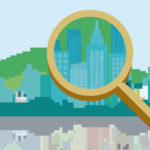The streets of New York's Chinatown, Granada's Sacromonte neighborhood, or Southall (London's Little India) are examples of how people tend to live near others from the same place or social status. But businesses, restaurants, and bars are just as important meeting places as where we live. Esteban Moro, Professor at Universidad Carlos III and MIT (Massachusetts Institute of Technology), uses big data tools to analyze how people interact in these places.

More and more it is easier and cheaper to move within cities. Studying how a city's population is distributed “based on where you are at three in the morning, in other words when you are asleep, doesn't make sense because the majority of what we do takes place kilometers away from where we live,” Moro explained at a conference organized at the BBVA Foundation as part of the series, Demography Today.
During his participation at the event, the Spanish physicist provided preliminary results of the research underway at MIT’s Media Lab, which uses an enormous repository of anonymous data that contains more than 80 billion geo-locations for 26 million mobile application users in different US cities.
The aim is to analyze a city's capacity to assimilate its neighbors, looking at cities in high resolution, zooming into their streets with an accuracy of barely 20 meters. This work would be practically impossible without big data tools and applications, states Moro. “Without data science, we would have needed more than ten years, using survey methods for example, to reach the same conclusions.”
The study's initial conclusions reveal, for example, that segregation within cities occurs within just a few meters. Establishments where there are people from different cultures and socio-economic levels can be found on the same street as those where there is no diversity.
Without data science, we would have needed more than ten years, using survey methods for example, to reach the same conclusions”
Additionally, the typology of places (restaurants, businesses, public facilities ...) that there are on a street or in a neighborhood determine the level of segregation. For example, areas near Asian restaurants or tapas bars have higher levels of integration and assimilation. On the other hand, Caribbean or Latin American restaurants are found in neighborhoods with greater levels of segregation.
Something similar happens when zooming in on educational institutions: elementary schools and high schools are the least integrated places in the United States. In their first years of schooling, children only have schoolmates from similar socio-economic backgrounds. “It’s a problem because, while we are educating our children, we are only presenting a very limited cross-section of society,” says Moro. Meanwhile, at universities or museums there is less segregation.
Big data to rearrange cities
The Urban Discovery project, developed by BBVA Data & Analytics provides another example of the power of big data to better understand city dynamics, even getting to the point of rearranging a city's maps. In this example, the data comes from 413 million credit card transactions made in Madrid, Barcelona, and Mexico City.
“With aggregated and anonymous data,” explains Juan Murillo, head of Territorial Analysis at BBVA Data & Analytics, “and thanks to data science, we can better understand the dynamics in these cities and examine how residents use them according to their lifestyle. If it is true that the ideal city should maintain a minimum spatial and social equilibrium, the reality does not bear this out: the conclusions of Esteban Moro's study and ours confirm that it is more and more possible to identify a specialization of each zone. The good news is that at the same time, we can measure how changes in the surrounding conditions (new businesses, new transportation infrastructure, urban renewal, or fluctuations in real estate markets) influence the residents’ patterns of behavior, and thus guides administrative decision-making.”

"Thanks to data science, we can better understand the dynamics in these cities and examine how residents use them according to their lifestyle"
Esteban Moro believes these types of studies represent an immense opportunity to “pop the bubbles in which we live. If we always see the same people, with the same socio-economic status as ourselves, we isolate ourselves, and that’s a problem. The question we want to answer is to what degree and how can we burst these bubbles.”
There have always been places in cities where people from different backgrounds, cultures, or socio-economic levels have mixed. As Moro explains, these gathering places, designated “third places” in the 1980s by the North American sociologist Ray Oldenburg, is where democracy, innovation, true citizenship emerge.
When Oldenburg published his theory, these places were in neighborhood bars and hair salons, or in the case of the United States even in bowling alleys. This model evolved, and in the 1990s these establishments–as well as the neighborhood shops–were replaced by big shopping centers. Now, more and more, “People stay at home. There is a profile of a resident, generally millennials and those in the previous generation, who buy, consume, and exchange products online,” Moro notes.
Social media networks are more segregated than cities
Faced with this change in consumption habits, social networks should have been destined to become the new gathering and exchange place, the “third place” in a digital society. However, “In our research, we have found that they are more segregated than our non-virtual society. Guided by social network algorithms, we only hear what we already think, we only meet or associate with people who are like us, we only talk with people who think the same as we do.”
Even though the initial results of the research are not very encouraging, Moro continues to trust in the power of our cities to integrate, in the need that people have to meet and interact with one another. “It is still not clear what will take the place of the shopping center as the new ‘third place.’ If, for example, it will be Amazon. Or maybe the consequence will be that since people have more free time because they don't have to go shopping, they can spend time doing outdoor activities, more sports, that we are moving toward that type of ‘third place’ But that's yet to be seen.”